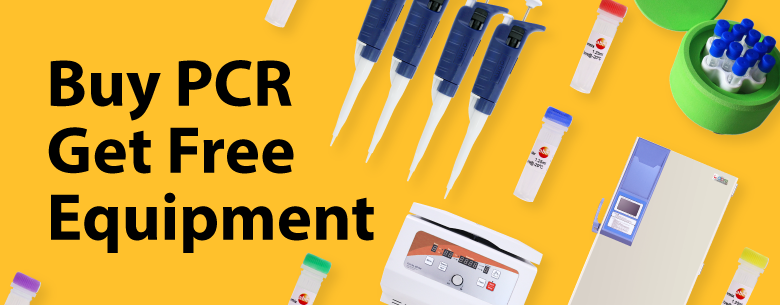qPCR Lentivirus Titer Kit
Specifications
| SKU | LV900 | |||||||||||||||||
| Name | qPCR Lentivirus Titer Kit | |||||||||||||||||
| Unit | 100 rxn | |||||||||||||||||
| Description |
The only kit on the market with complete elimination of NTCabm’s qPCR Lentivirus Titer Kit is a one-step assay which employs a quick RNA extraction step that is followed by RT-qPCR. Designed to deliver high sensitivity and specificity, the kit ensures minimal non-specific background and better overall performance compared to similar kits on the market. ROX reference dye is provided separate from the MasterMix, making this kit universally compatible with most qPCR instruments. Kit Features:
|
|||||||||||||||||
| Storage Condition |
Store at -20°C. This product is stable for 2 year from the date of shipping if stored and handled properly. |
|||||||||||||||||
| Note |
qPCR Lentivirus Titer Kit comes with a separate vial of ROX Reference Dye which can be added depending on the qPCR machine type, as listed in the table below.
|
FAQs
| Why do I get higher titers for the more diluted sample from the same stock? | |
|
This means your virus stock may have strong PCR inhibitors in the sample. Thus, it would best to trust the more diluted samples' results, as it lessens the inhibitor's influence.
|
| Will the transfected plasmids used to produce the lentiviral particles interfere with the qPCR results? What about the host's genome? | |
|
The transfection plasmids and host's genome remain in the packaging cells while the viral particles are harvested from the supernatant. The titering process will not involve the cells, thus the plasmids and genome will not interfere with the results as well.
|
| Can this kit titer FIV particles? | |
|
No, this kit cannot titer FIV particles.
|
| My experiment needs MOI=10. How can I know that viral particle? How to IU(infectious units)/ml convert to viral particle? | |
|
Multiplicity of Infection (MOI) Calculation Method: MOI = (Product Titer (IU/ml) x Virus Volume (ml)) /Total Cell Number For example, to achieve a MOI of 10 with a 1 x 10^6 IU/ml titer virus on 1 x 10^5cells, use 1.0 ml of the virus.
|
| Does your titration kit work with pLKO.1 based siRNA lentivirus? | |
|
Our titer kit should be able to detect pLKO.1 vector with an qPCR product size of about 100 bp.
|
| Can I use this kit to exclude the generation of replication competent lentivirus (RCL) in previously infected cells (stable cell lines?) so I can safely transfer them to Biosafety Level 1? | |
|
Yes, this kit can be used to determine that no replicative competent virus is being produced by previously infected cells. It is important to consult with the health and safety officer(s) at your own institution in order to determine if infected cells can be transferred to Biosafety Level 1.
|
| Is this kit suitable for titrating retroviruses and adenoviruses? | |
|
No, this kit is designed for Lentiviruses only.
|
| The dissociation curve shows that the Tm of my Lentivirus is lower than that of standards, why? | |
|
The Tm of a qPCR product is mainly depending on two variables: the reaction mixture's chemical compositions and the sequence of the amplicon. Since all the reactions in this case have almost the same compositions (ex: all the input templates are basically water, not for instant high salt template solution), the main variation would be in the template sequence. It is possible that your the vector has a slightly different sequence (likely having less GC content) than our std's sequence, thus having a lower Tm than the Std.
|
| Will the qPCR Lentivirus Titration(Titer) Kit amplify the integrated genomic region of the lentivirus? | |
|
No, the qPCR Lentivirus Titration (Titer) Kit (Cat#LV900) will not amplify the integrated genomic regions of lentivirus because the primers amplify the 5' LTR of the lentivirus.
|
| Does the assay detect free viral RNA and so overestimate the viral titer? If so, is there a way to minimize this? | |
|
In theory, it is possible for our Cat#LV900 to detect free viral RNA and free viral RNA can be present in the supernatant collected during lentivirus production, however this should not impact the titer to any significant extent and should be very minimal in detection, if any. If desired, you may wish to further purify your virus using our Ultra-Pure Lentivirus Purification Kit (Cat#LV998) or Speedy Lentivirus Purification (Cat#LV999) to remove any free viral RNA. However, we have never encountered any issues using our LV900 kit and free viral RNA has not been a factor; we use this kit regularly during our routine QC processes, and it is one of the most popular products in our catalogue.
|
| For lenti titering, is it possible to start with an ultracentrifuged lenti sample (suspended in PBS) as opposed to straight supernatant? | |
|
Yes, starting with an ultracentrifuged lenti sample should indeed be suitable for use with our qPCR Lentivirus Titration(Titer) Kit (LV900).
|
| Is this kit suitable for detecting both 2nd and 3rd generation lentivirus? | |
|
Yes, the kit is suitable for detecting both 2nd and 3rd generation lentivirus.
|
| What type of vectors will this kit work with? | |
|
The titer primers supplied in LV900 are designed for all HIV-1 based viral detection.
|
| Is DNAse treatment required after harvesting the lentivirus stock? | |
|
DNase treatment is not recommended. When packaging lentivirus, we recommend removing the transfection medium from the cells after overnight incubation, and replace with complete culture media for the cells. Incubate another 24 hours, and then collect the supernatant.
|
| What is the primer design based on? | |
|
The primers in this kit uses a set of proprietary sequences designed based on the 5'LTR region.
|
| How come my cells are not successfully infected with the evaluated titer from the kit? | |
|
One important thing to note is that the infection success is dependent on the cell type. Some cells may be more susceptible than others for viral infection. Thus, the same number of infectious units may perform differently on different cell types.
|
| Does the standard need to be diluted each time? Can diluted standards be used multiple times? | |
|
It is advised to dilute the standard fresh each time as the diluted standards might be degraded over time, thus compromising their accuracy.
|
References
- Bushnell, G. G., Rao, S. S., Hartfield, R. M., Zhang, Y., Oakes, R. S., Jeruss, J. S., & Shea, L. D. "Microporous scaffolds loaded with immunomodulatory lentivirus to study the contribution of immune cell populations to tumor cell recruitment in vivo" Biotechnology and bioengineering. : (2019).
- Johnson, J. O., Chia, R., Brown Jr, R. H., & Landers, J. E. "Mutations in the SPTLC1 gene are a cause of amyotrophic lateral sclerosis that may be amenable to serine supplementation" : (2019).
- Keshwara, R., Hagen, K. R., Abreu-Mota, T., Papaneri, A. B., Liu, D., Wirblich, C., … Schnell, M. J. "A Recombinant Rabies Virus Expressing the Marburg Virus Glycoprotein Is Dependent upon Antibody-Mediated Cellular Cytotoxicity for Protection against Marburg Virus Disease in a Murine Model" Journal of Virology 93(6): (2018). DOI: 10.1128/jvi.01865-18.
- Long, K. L. P.. "The role of oligodendrocytes and myelin in differential susceptibility to stress-induced anxiety (Doctoral Thesis)" University of California Berkeley:United States (2018).
- Rahal, O. M., Nie, L., Chan, L. C., Li, C. W., Hsu, Y. H., Hsu, J., ... & Hung, M. C. "Selective expression of constitutively active pro-apoptotic protein BikDD gene in primary mammary tumors inhibits tumor growth and reduces tumor initiating cells" American journal of cancer research 5(12):3624 (2015).
- Schatoff, E. M., Zafra, M. P., & Dow, L. E. "Base editing the mammalian genome" Methods 164–165:100–108 (2019). DOI: 10.1016/j.ymeth.2019.02.022.
- Scheben, A., Wolter, F., Batley, J., Puchta, H., & Edwards, D. "Towards CRISPR/Cas crops - bringing together genomics and genome editing" New Phytologist 216(3):682–698 (2017). DOI: 10.1111/nph.14702.
- Tsai, . "U" S. Patent Application No.0015473 A1 : (2019).
Controls and Related Product:






